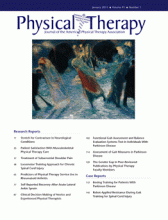Abstract
Background The minimal detectable change (MDC) is the smallest amount of difference in individual scores that represents true change (beyond random measurement error). The MDCs of the Timed “Up & Go” Test (TUG) and the Dynamic Gait Index (DGI) in people with Parkinson disease (PD) are largely unknown, limiting the interpretability of the change scores of both measures.
Objective The purpose of this study was to estimate the MDCs of the TUG and the DGI in people with PD.
Design This investigation was a prospective cohort study.
Methods Seventy-two participants were recruited from special clinics for movement disorders at a university hospital. Their mean age was 67.5 years, and 61% were men. All participants completed the TUG and the DGI assessments twice, about 14 days apart. The MDC was calculated from the standard error of measurement. The percentage MDC (MDC%) was calculated as the MDC divided by the mean of all scores for the sample. Furthermore, the intraclass correlation coefficient was used to examine the reproducibility between testing sessions (test-retest reliability).
Results The respective MDC and MDC% of the TUG were 3.5 seconds and 29.8, and those of the DGI were 2.9 points and 13.3. The test-retest reliability values for the TUG and the DGI were high; the intraclass correlation coefficients were .80 and .84, respectively.
Limitations The study sample was a convenience sample, and the participants had mild to moderately severe PD.
Conclusions The results showed that the TUG and the DGI have generally acceptable random measurement error and test-retest reliability. These findings should help clinicians and researchers determine whether a change in an individual patient with PD is a true change.
Footnotes
Ms Huang, Dr Hsieh, and Mr Lu provided concept/idea/research design and writing. Ms Huang, Dr Wu, Dr Lin, and Mr Lu provided data collection. Ms Huang and Mr Lu provided data analysis and project management. Dr Hsieh provided fund procurement. Dr Wu and Dr Tai provided participants. Dr Wu provided facilities/equipment and institutional liaisons. Dr Hsieh and Dr Wu provided consultation (including review of manuscript before submission). The authors are grateful to all participants for their participation.
This study was approved by the Medical Ethics Committee of National Taiwan University Hospital.
This work was supported by the National Science Council (NSC96-2628-B-002-034-MY3) in Taiwan.
- Received April 15, 2009.
- Accepted August 13, 2010.












